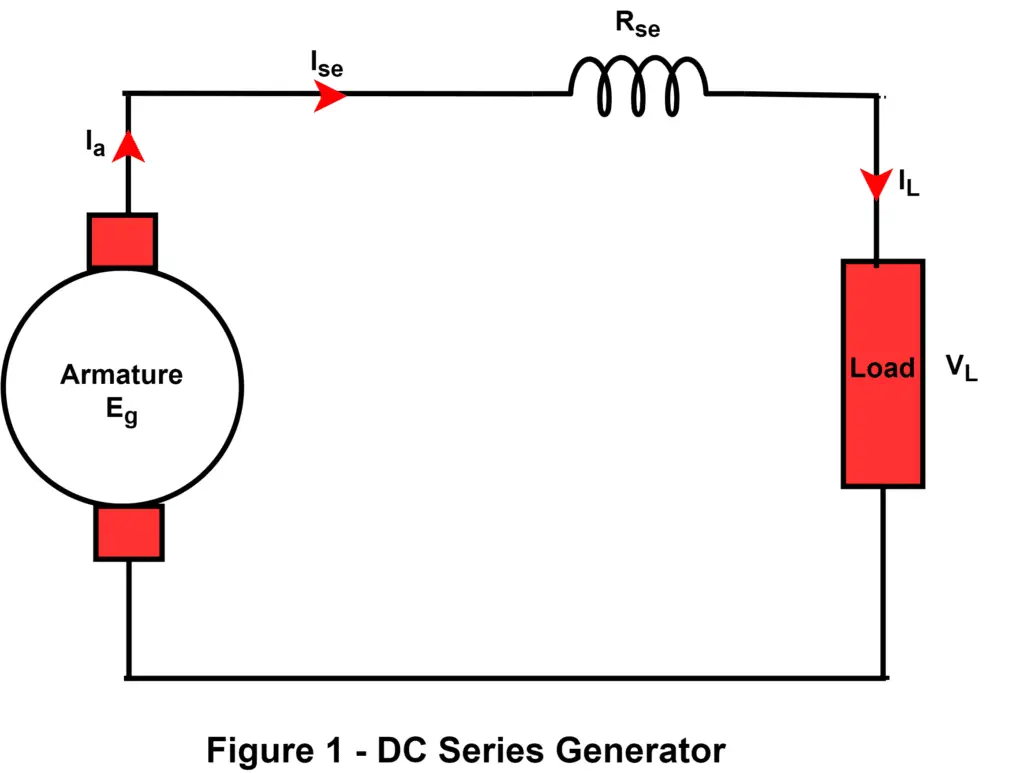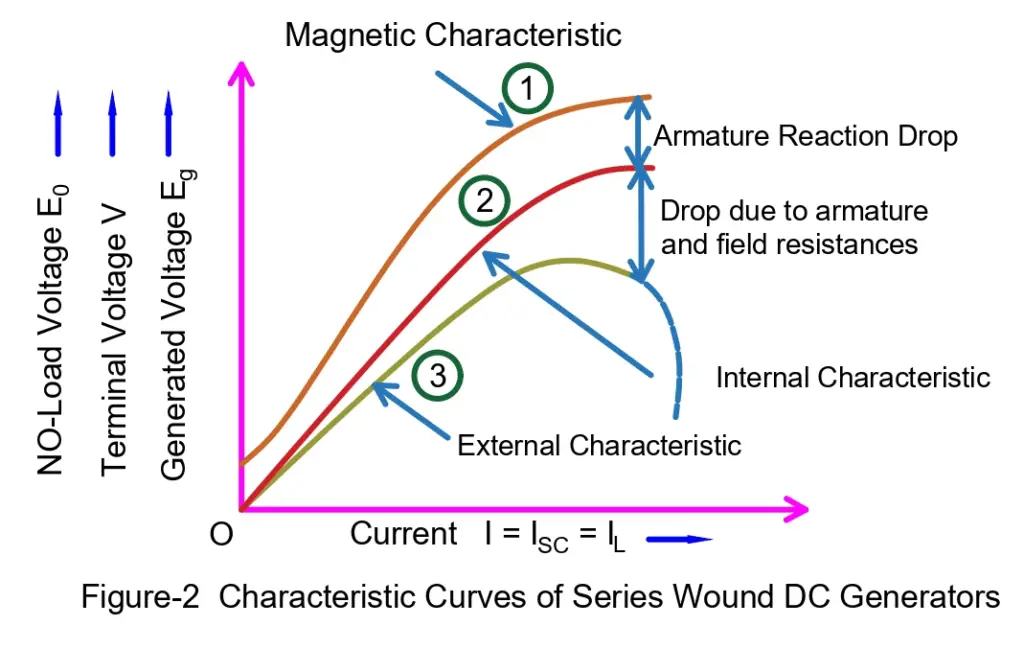In this article, we shall discuss the different characteristics of a series-wound DC generator. A DC series generator is one in which the field winding is connected in the series with the armature winding. The circuit diagram of a typical DC series generator is shown in Figure 1.

Since, in this type of DC generator, the field winding is connected in series with the external electrical load, Consequently, it carries the whole load current. Therefore, the series field winding is always designed to have the least resistance.
From the circuit of the series DC generator, it is clear that the same electric current flows through the armature winding, field winding, and external electrical load, i.e.

Where,
- Ia is the armature current,
- Ise is the series field current and
- IL is the load current.
Basically, the characteristics of a DC series-wound generator are the graphs that give information about the behavior of the generator in different aspects. Generally, there are three main characteristics of a series-wound DC generator that are used to analyze the behavior of the generator. These characteristics of the DC generator show the relationship between the various electrical quantities like field or excitation current, load current, generated voltage, and terminal voltage.
- Open Circuit or Magnetic Characteristic
- Internal Characteristic
- External Characteristic
1. Open Circuit or Magnetic Characteristic of DC Series Generator
A series-wound DC generator’s open-circuit characteristics or magnetic characteristics are plotted in the graph between no-load voltage and field excitation current. This characteristic shows the behavior of the generator under no-load conditions. The open-circuit characteristics(OCC) are also known as the no-load saturation curve.
The open circuit characteristic is obtained by disconnecting the series field winding from the generator circuit and excited separately from an external source. It is done because, during no load, there is no current flowing through the series field winding.

The open-circuit characteristics of the series-wound DC generator are shown in curve 1 in Figure 2. From the curve, we can see that the linearity of the curve will continue till the saturation of the core material of the poles. Once the pole core is saturated, there is no significant change in the voltage produced by the generator with the increase in the field current.
This characteristic also shows that there is a residual magnetism (the curve is started a little way up to the origin), which develops a small initial voltage across the armature of the generator.
2. Internal Characteristics of DC Series Generator
The curve that shows the relation between generated emf in the armature winding and the load current of a DC series generator is known as an internal characteristic of the series-wound DC generator.
In practice, this characteristic curve is obtained by finding the difference between no-load voltage and the voltage drop due to the demagnetizing effect of the armature reaction. Thus, this characteristic curve shows that the actually generated emf (Eg) by the generator is always less than the emf generated at no-load, i.e., E0. For this reason, the internal characteristic curve is slightly dropping from the curve of the open circuit characteristic. In Figure 2, curve 2 shows the internal characteristics of the DC series generator.
3. External Characteristics of DC Series Generator
The characteristic curve that shows the relation between the variation of terminal voltage (VL) and the load current (IL) of a DC series generator is called the external characteristic of a series-wound DC generator.
For a DC series generator, the terminal voltage is obtained by subtracting the voltage drops in armature and series field resistance from the total generated emf (Eg).

Practically, the curve showing the external characteristic lies below the internal characteristic curve. This is because the value of the terminal voltage is less than the generated voltage. In Figure 2, Curve 3 shows the external characteristics of the DC series generator.
Conclusion
From the characteristics of the series-wound DC generator, it is clear that the terminal voltage increases with the increase in the load on the generator. However, once it attained the maximum values, it started decreasing due to the excessive demagnetizing effect of the armature reaction, as shown in Figure 2.
In the case of a series-wound DC generator, field and armature currents increase with the increase in the load current because they are connected in series. However, due to magnetic saturation, there will be no significant increase in the magnetic flux and hence in the induced voltage. However, because of the increasing armature current, the effect of the armature reaction increases significantly and causes a significant drop in the terminal voltage. This drop in the terminal voltage decreases the load current in a proportional manner.
Thus, for a DC series generator, the increase in load increases the load current but decreases the load voltage, which in turn decreases the load current. Therefore, due to these two simultaneous effects, there is no considerable change in the load current. That is why a DC series generator is considered a constant current DC generator.